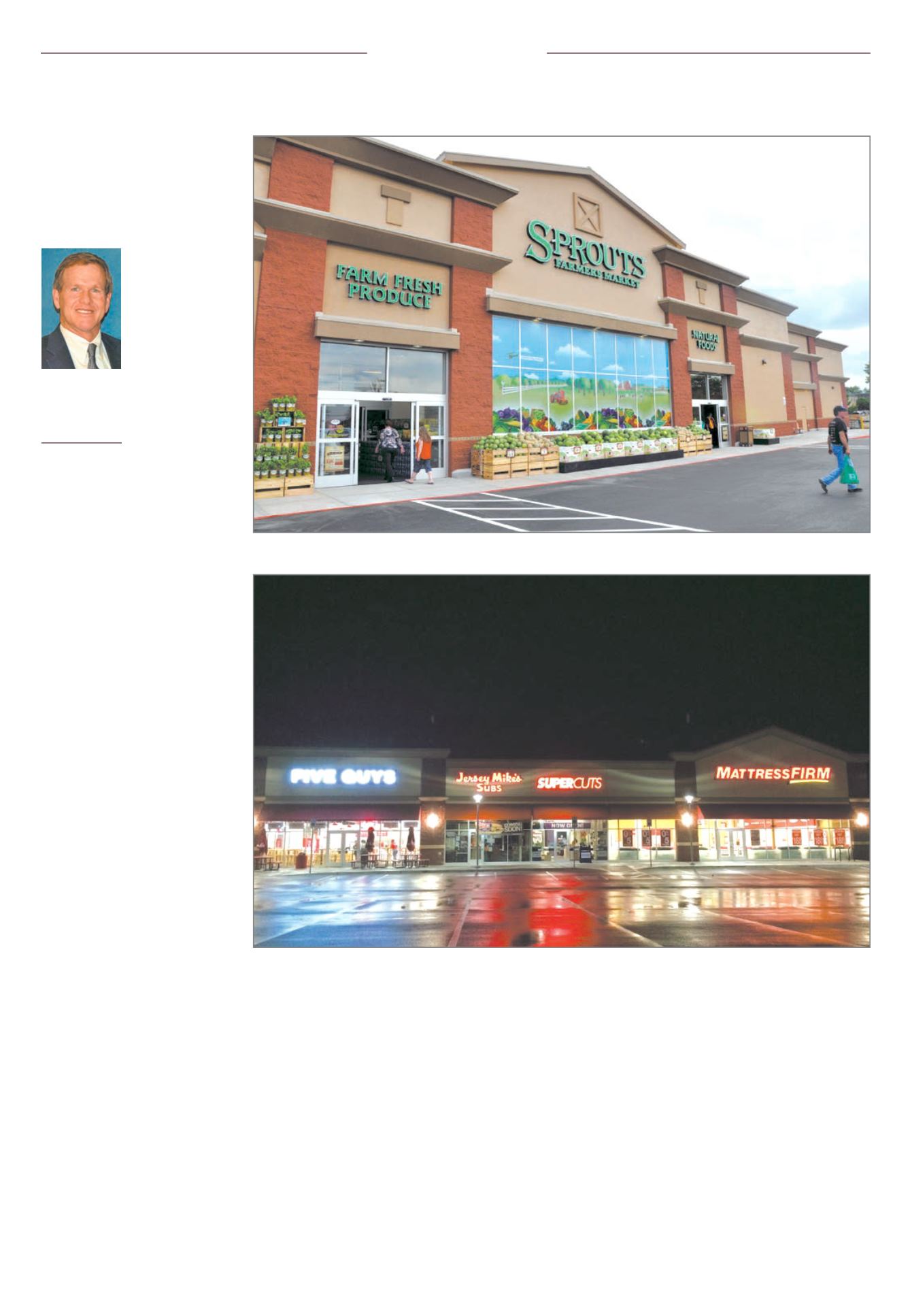

February 2015 — Retail Properties Quarterly —
Page 9
W
hen working at Trammell
Crow Co. in the late 1990s,
I led a group undertaking
single-tenant, retail and
build-to-suits all over the
United States. We developed many
projects throughout the country
and even outside of the contiguous
U.S., including Alaska and Puerto
Rico. We would
build the same
building with the
same lease for all
of our clients in
different markets.
I always found it
interesting how
many almost iden-
tical properties we
could sell, but the
price would vary
somewhat dramat-
ically.
We built an
OfficeMax in
Ponce, Puerto
Rico, and the lease was in English.
However, all the underlying docu-
ments were in Spanish. I have to
admit, relying on a local lawyer
to interpret and approve all of the
underlying documents that were in
Spanish was daunting. The location,
language issue and the fact that
you could not do 1031 exchanges in
a U.S. territory at the time, pushed
the cap rate and we were able sell
the property up 100 basis points
higher than what the same lease
and building prototype sold for in
similar locations in the continental
U.S. This was in spite of proven high
sales figures for retailers like Office-
Max in Puerto Rico. I decided after
that deal to always factor in some
of the more intangible factors that
influence real estate investors.
Since 2002, we have been invest-
ing in and developing properties
in Colorado and California. I am
amazed at the special connection
these two markets have and the
benefits that Colorado gains from
California investors’ infatuation
with our real estate.
Many elements go into property
valuations. Factors include the
quality of the improvements and
the location, quality and length of
the income stream, and, maybe
most important, the amount of the
income stream.
Colorado real estate generally
gives California investors a slightly
higher return, which, without a
doubt, is a factor. However, the
mountain resort image of our state
and the lifestyle, along with a lot of
direct flights are big differentiators
that should not be overlooked.
In my experience, Kansas City,
Missouri, from a cap rate perspec-
tive, is penalized for being flat, Min-
neapolis for being cold, and Cleve-
land for, well, being Cleveland.
We are blessed with beautiful
mountains, great weather and a
healthy lifestyle within which Cali-
fornians connect.
Of course, as Coloradans we
would like to pat ourselves on the
back and say this infatuation exists
because of the vibrant economy and
quality communities that we have
created. One might argue we have
had little to do with it, but rather
the landscape, proximity to Califor-
nia and weather are blessings we
are fortunate enough to have.
We have an image created by the
physical beauty, weather and life-
style that attract real estate capital
from other parts of the country, but
especially from California.
Most Californians are proud that
they live in a state with beautiful
mountains, beaches and very pleas-
ant weather. The massive metroplex
stretching from Ventura County
north of Los Angeles, to the Mexi-
can border in San Diego is one of
greatest economic engines in the
history of the world. The Bay Area
in the north is not as large, but
extremely significant. Add it all up
and that is a lot of real estate worth
a lot of money.
Real estate prices in these mar-
kets are high with low cap rates.
I found that when an owner of a
small apartment building in Los
Angeles sells his property for a
4 cap, often the joy of selling is
tainted by the fact that in order to
buy something else in California,
it’s going to command the same
crazy cap rate. To get an acceptable
return, he would have to aggressive-
ly raise rents and drive net operat-
ing incomes up.
Many owners decide to look out-
side California for better returns.
This is where the Colorado con-
nection seems to flourish. Over
and over again when selling retail
assets, buyers from California step
up to the plate and close on deals
over local investors. Comments like,
“I have always taken my kids skiing
in Vail, so I would love to own prop-
erty there,” or “Colorado is such a
beautiful place,” are anecdotal com-
ments I hear.
What I have not heard is, “I
want to own real estate in Colo-
rado because of the legalization of
marijuana.” Actually, I have heard
statements to the contrary. And our
neighbor to the west, Utah, is gain-
ing more investor interest because
of some of the high-profile deci-
sions and events that may negative-
ly affect Colorado’s image.
In my experience, sometimes not
many sophisticated economic met-
rics like demographics and employ-
ment growth are being applied.
It is an image and a connection
that Colorado has with California.
These are investors buying assets
under $5 million, and they are not
institutional in nature. However,
they are not short on real estate
savvy and typically manage assets
in a competitive California market-
place to get to where they are. They
also have a lot of money to place
when they sell even the smallest of
assets.
If you own smaller retail assets,
especially single-tenant, triple-net
assets, you should make the Cali-
fornia connection when you go to
sell. In addition, we should all care
about the image and perception of
our state.
s
California dreamin’ for Colorado cap ratesMarket Driver
Greg Ham
Chief operating
officer, co-founder,
Cadence Capital
Investments,
Greenwood Village
This strip mall was also completed as part of the project with Sprouts, which sold to an international company, represented by a
California broker.
Sprouts grocery store, part of a project completed at South Broadway and East Belleview Avenue, is a prime example of California
capital investing in Colorado properties.
















